Is your kitchen lacking a little sparkle and shine? Or perhaps there might be a few areas that you're not quite sure how to tackle.
Well, there's no need to panic as our expert has shared their ultimate kitchen cleaning guide to keeping your kitchen spick and span, with some of the best cleaning tips and tricks for all year round.
How to clean the washing machine

When using your washing machine regularly, dirt, hair and other bacteria tend to get stuck in the detergent dispenser, drum and rubber gasket, resulting in the growth of mould and mildew. This builds up over a period of time, and if not properly cleaned, can cause an odour and affect the cleanliness of your laundry.
Luckily, there are a number of different steps you can take to prevent your washing machine from smelling:
1. Use white vinegar and baking soda
White vinegar is an excellent natural household product to use to clean your washing machine. Simply pour two cups of white vinegar into your detergent dispenser on a hot cycle, then add half a cup of baking soda and begin another hot cycle. This is particularly effective as the acidity of the vinegar kills bacteria and cuts through grime, whilst the baking soda is great at removing tough stains. Combined together, this should make for an easy clean.
2. Clean the filter monthly
To keep your washing machine in optimal condition, it’s important to stay on top of cleaning the machine’s filter. Lint, debris and hair accumulates over time, which can clog up the machine and result in it being unable to complete a wash cycle. You may also start to notice drainage issues and that your clothes are dirty even after washing them.
To prevent this from happening, clean your washing machine filter every month to keep it running efficiently. When it comes to cleaning, ensure the machine is switched off and unplugged before removing the filter. Use a soft-bristled brush or cloth to remove any debris from the filter and then secure it back in place once done.
3. Do a deep clean
There are various factors that affect how often you should be cleaning your washing machine, including usage, water hardness, and the type of detergent you use. We recommend rinsing down the detergent drawer every few washes to avoid build up, whilst cleaning the rubber gasket should be done monthly. If you’re noticing the washing machine is starting to develop a foul odour, then reduce the time in between cleaning to make sure it’s as hygienic as possible.
To maintain the longevity of your washing machine and combat foul smells, ensure you’re leaving your washing machine door open after each wash. Not only will this encourage ventilation, but it will also prevent bacteria from growing. Another simple way to prevent odours, is to swiftly take your laundry out as soon as the cycle ends to minimise the chances of mould growth from the dampness.
How to clean silver at home
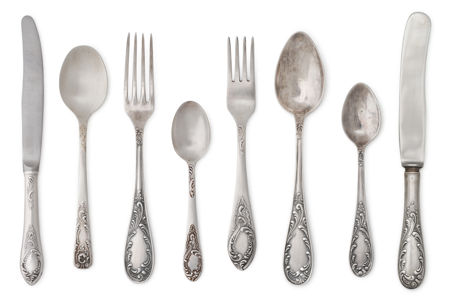
Whether you’re serving Sunday lunch, or hosting a gathering, you’re going to want your cutlery to shine and look brand new. Here’s how to do that:
1. Aluminium and baking soda
The first trick is very simple. Place your silver cutlery in a large bowl lined with aluminium foil, shiny side up. Pour hot water into the bowl until the cutlery is completely covered, and add baking soda (about half a cup to every 2 litres of water). Leave the silver aside for at least 30 minutes, then once the water has cooled down, remove the cutlery and rinse well. Lastly, dry with a clean cloth to restore your silverware back to its original vitality.
2. Ketchup
If you don’t have baking soda to hand, then try out this ketchup hack instead. Not only is it the perfect sauce to dunk your food in, but this household staple can also polish up silverware in a few easy steps.
Simply squeeze a few drops of ketchup onto a paper towel and use this to thoroughly wipe your cutlery. You may find using a soft-bristled toothbrush helpful to target any stubborn stains. Alternatively, you can also submerge your silverware in a bowl of ketchup for 5-10 minutes. Then, remove, rinse with warm water, and buff with a clean cloth.
3. Mayonnaise
Similar to ketchup, mayonnaise is another condiment that works wonders on your silverware. Using the same bowl method, submerge your silverware in mayonnaise for 15 minutes before removing, rinsing with warm water, and drying.
Do you have any brass that you’re also looking to clean and prepare ahead of hosting guests? Take a read of our in depth guide on cleaning brass here.
How to clean a dishwasher
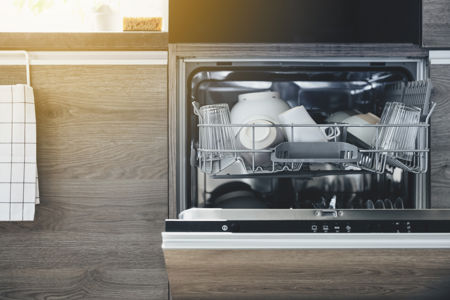
Smelly dishwashers can occur due to a dirty filter, mould on the gasket seal or a clogged drain. Not only can this lead to foul smells, but it can also reduce your appliance’s performance which can result in unclean dishes. Maintaining a regular cleaning schedule can help prevent this from occurring. Here are the quick and easy steps you can follow:
1. Empty the dishwasher
Begin by removing any dishes, glasses and utensils from your dishwasher, in order to gain easy access to the interior.
2. Clean the filter
Each dishwasher varies, but as a general rule, pull out the bottom rack and remove the filter. You should be able to find instructions on how to do this either in your dishwasher’s manual or online.
Next, proceed to empty the filter of any leftover food and debris. Soak the filter in warm, soapy water, using a soft-bristled brush to gently scrub any stubborn dirt, before installing it back inside.
3. Clean the interior with white vinegar and baking soda
To clean the interior, pour 250ml of white vinegar into a dishwasher safe container and place this upright in the lower rack of your machine. You should notice a cleaner dishwasher once you’ve run a normal cycle with the container inside and the heat dry option turned off.
Once the cycle has finished, sprinkle 1 cup of baking soda in the bottom and run a hot water cycle. Repeat this on a monthly basis to keep your dishwasher smelling fresh and looking clean.
4. Clean the gasket seals
Mould and mildew can easily grow in the crevices of the gasket seals, which can lead to a foul smelling dishwasher. To combat, make up a solution of warm water and soap and then use a sponge to wipe away any build up. Next, use a clean towel to wipe it dry.
How to clean an oven
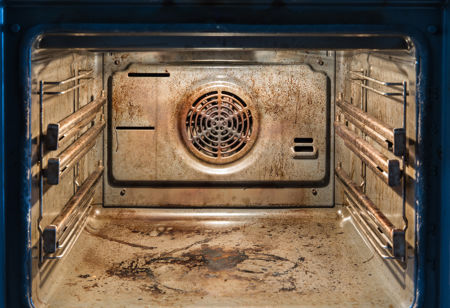
With our cleaning survey showing that Brits voted “cleaning the oven” as the second most hated chore, it’s no surprise that many of us procrastinate with keeping up with the maintenance and cleanliness of this appliance.
Although it’s a monotonous task, cleaning your oven has a number of benefits such as; safety, taste, hygiene and money. Not only can a clean oven decrease the chances of food contamination by getting rid of grease build up, but it will also use less energy as a result of heating up quicker. Keep your oven spick and span by following these six simple steps:
- Switch off your oven at the mains and remove the door
- Remove the racks and place them in the bath with hot water and laundry powder for deep cleaning
- Returning to the oven, wipe around the hinges with a kitchen towel to remove excess food and dirt (you can use a scraper for larger build ups)
- Use an oven cleaner or a homemade solution to soak the inside of your oven
- Leave to soak for 30 minutes, before wiping clean
- Complete the deep clean by using a natural glass cleaner on the oven doors
Nancy’s tea bag trick for oven dishes
For those of you who are avid tea drinkers, your tea bags are actually multipurpose as they are a great natural product to remove stubborn stains, as well as make a great brew!
Nancy shares, “Tea bags contain tannins that help to naturally degrease and loosen food grime. To get rid of burnt in stains and grime on oven dishes and other non-electrical appliances, soak them in the sink overnight with a few tea bags and this should help bring back that gorgeous shine they once had.”
Read on for a detailed step-by-step guide on how to clean an oven.
How to clean the microwave
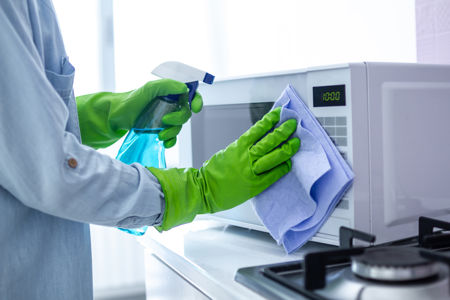
Perhaps one of the most convenient appliances in the kitchen, your microwave can quickly harbour bacteria and become a nuisance to clean if left neglected for too long.
To get rid of bacteria and keep your microwave smelling fresh, fill a microwavable bowl halfway with water and half a lemon. Heat this on high power for 3-5 minutes to create steam, and then dampen a cloth in the water to wipe away the grime from the interior of the microwave.
The acidity in lemon makes it the perfect cleaning agent as it breaks down bacteria and mould and also cuts through grease and staining.
Another handy alternative to lemon is white vinegar. Let the microwave run for 2-3 minutes with a microwave safe bowl filled with two tablespoons of white vinegar to two cups of water. Once the timer has gone off and you’ve removed the bowl, you’ll find it much easier to wipe away any stains with a cloth.
To keep your microwave in the best shape possible, ensure you’re wiping the inside after every use, and never use harsh chemicals or bleach to clean, as this may damage it.
How to clean an air fryer
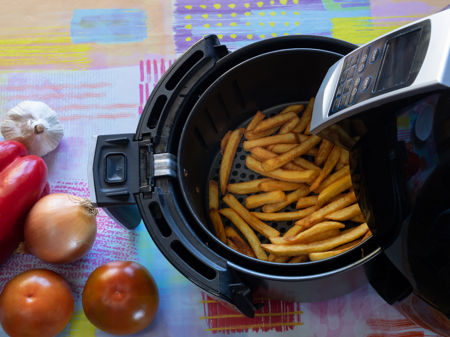
Air fryers have steadily become a big favourite in many households. Not only are they more energy efficient, but they also provide a healthier cooking method for popular meals. But with all of that use, it’s vital to keep it clean to ensure food tastes its best and the air fryer stays in tip top working condition.
Whilst many of us may use this once or twice a day, it’s recommended to clean the baskets after every use to prevent it being a nightmare to scrub later.
Before washing your airfryer, make sure that you wipe around the basket with a clean kitchen towel as the last thing you want to do is pour grease and fat down the drain - this will only lead to bigger problems.
Here’s a step by step cleaning guide to keep your air fryer in great working order:
- Turn off your air fryer at the plug
- Fill your sink with hot, soapy water (dish soap is fine)
- Remove the basket and pop the tray in the sink to soak
- Wash with a traditional washing up pad that has a soft sponge and scourer side as using too much force could scratch the surface of your fryer. Do the same with the tray
- Then wipe over both the tray and the basket with a clean soft cloth
- Next, get a clean microfibre or soft cloth and soak it in warm water to wipe around the inside of the air fryer where the basket sits. You can even wipe around the heating element as long as it is completely cool before doing so
How to clean stainless steel
Stainless steel is a common feature in many kitchens - from fridges, kitchen sinks and dishwashers, to smaller household appliances such as kettles, toasters, microwaves, and pots and pans - knowing how to keep stainless steel looking brand new is a handy trick to have up your sleeve.
However, there are multiple ways to clean stainless steel, and it all depends on the item, its condition and what you have to hand.
1. A damp cloth
Most stainless steel appliances, no matter the size, can be refreshed by simply using a clean, wet microfiber cloth. Similar to wood, stainless steel has a grain, so wipe in the same direction, and use a dry towel to finish.
2. Steam cleaning
If your stainless steel needs a deeper clean, using a steam cleaner is an effective way to sterilise and disinfect without causing any scratches.
3. White vinegar
Once again coming to the cleaning rescue is white vinegar. Using a solution of two parts water to one part vinegar can be effective in removing stubborn grease spots. Simply wipe the surface with your homemade concoction and rinse immediately with a clean cloth.
Remember not to allow your appliances to air dry after cleaning as this may leave streaks, reducing your stainless steel’s shine. If you also have a ceramic sink in the house, then have a read of our guide on how to clean a ceramic sink.
How to clean kitchen taps
It’s normal to get a build up of grime, dirt and stains around your kitchen tap, no matter what material it’s made of. Luckily, keeping them clean and looking new is an easy feat.
If you’ve opted for a special finish tap such as matt black taps, chrome or brushed brass taps, it’s especially important to avoid using harsh chemicals such as vinegar when cleaning.
A simple and quick alternative is to use a soft cloth and warm soapy water to keep your taps pristine. Alternatively, you can also clean with a 75/25 lemon juice and water solution for a tougher clean. It’s important to ensure this isn’t left on the taps to soak for more than a couple of minutes before rinsing, and always use a soft cloth to clean.
For more tips on how to care for our kitchen and bathroom products visit the Product Care Hub
How to descale a kettle
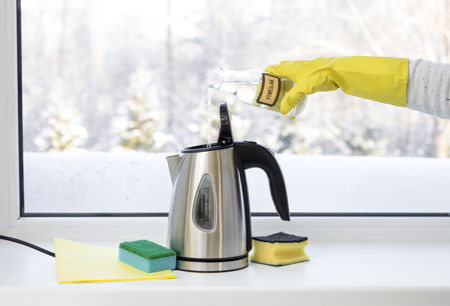
There’s two very easy ways to do this:
- Fill your kettle with equal parts of distilled white vinegar and tap water. Bring to the boil and empty the contents down the sink. Next, fill your kettle with just water and boil again to remove any excess vinegar. Repeat this process until no vinegar is left.
- Alternatively, start by cutting a lemon in half and putting the slices inside the kettle with half to three quarters full of water. Bring to the boil, then let it sit for 10 minutes and boil again. Empty the contents into the sink, rinse, and your kettle is ready for your next brew.
How many of these most searched for cleaning hacks did you already know? For more tips on making cleaning your kitchen a breeze, read up on our spring cleaning guide.










